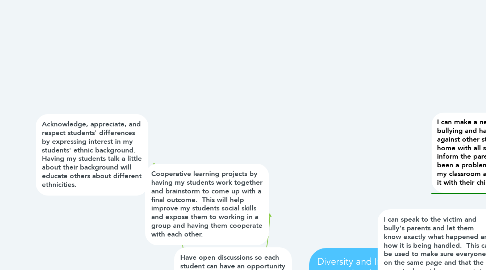Diversity and Inclusiveness in the classroom
by Grace Verslues

1. Acceptance and Inclusiveness of all students
2. Acknowledge, appreciate, and respect students' differences by expressing interest in my students' ethnic background. Having my students talk a little about their background will educate others about different ethnicities.
3. Clearly structured small group activities that encourage everyone to participate. This will help my students understand what we are learning in class and hearing it from another student explain something could help them remember the material.
4. Cooperative learning projects by having my students work together and brainstorm to come up with a final outcome. This will help improve my students social skills and expose them to working in a group and having them cooperate with each other.
5. Have open discussions so each student can have an opportunity to have their input and express their view on the topic.
6. Involve all learners in my lessons, if this does not happen students can become less engaged in my classroom. I can do this by asking questions and splitting my students up into groups to answer so that way all students have a chance to get involved.
7. Promote a positive school and classroom climate so I can explain the expectations of the classroom and promote student learning through group cohesiveness.
8. Addressing bullying and hateful language against your students
9. I can make a newsletter about bullying and hateful language against other students and send it home with all students. This can inform the parents if there has been a problem with bullying in my classroom and they can discuss it with their child if they choose to.
10. I can speak to the victim and bully's parents and let them know exactly what happened and how it is being handled. This can be used to make sure everyone is on the same page and that the parents do not hear one point of view from their child.
11. I can have the bully write an apology letter to the victim and have the bully personally give it to the victim.
12. Carefully observe my students conflict-resolution abilities by paying more attention to the interactions in the classroom. Sometimes students try to resolve conflict before going to the teacher, they approach the teacher as a last resort.
13. Scaffold, compromise, and negotiation, rather than disengagement when intervention appears necessary. This is to make sure the student knows what is going on and why an intervention is happening, I can do this by using a variety of instructional techniques.
14. Responding to teasing or exclusion by other classmates
15. I can be authoritative and negotiate, give-and-take, be fair, and respect others point of view by listening to what the students have to say.
16. Promote emotional competence- when students can respond appropriately can control their emotions, conflicts can be resolved more constructively.
17. Intervene immediately and do not wait to see the outcome because the situation could gradually get worse to some extent.
18. Have the bully fill out a "think sheet" by having the student write why his/her actions were wrong and how it hurt the victim. This helps with making sure the bully knows what went wrong and how it hurt the victim.


